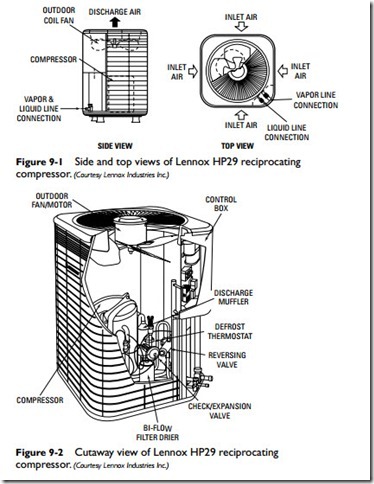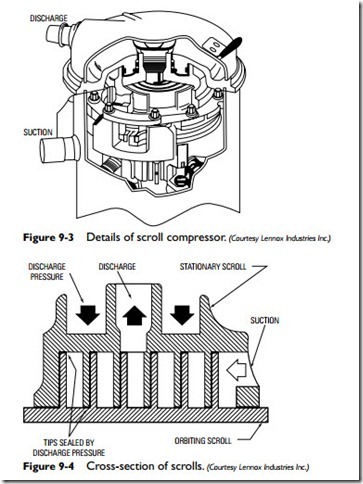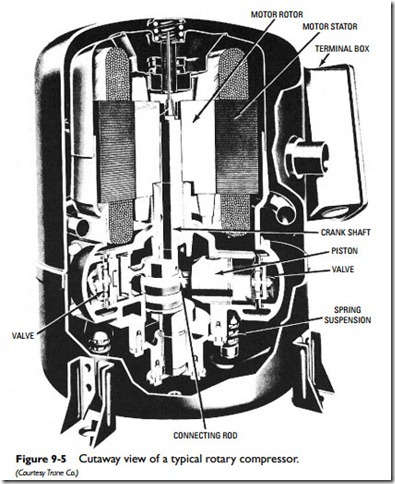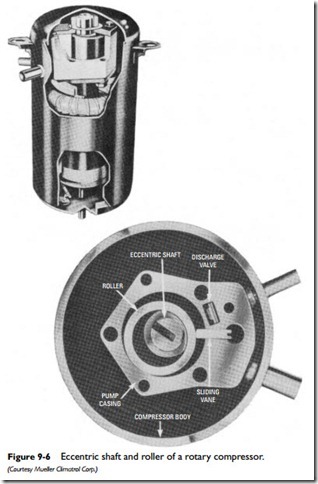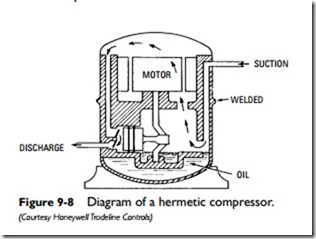The gas compression method of mechanical refrigeration used in conjunction with an air-cooled condenser is probably the most common cooling system used in residences and small commercial buildings. For that reason, this chapter is devoted almost exclusively to a description of mechanical refrigeration equipment.
A typical central air-conditioning system cools the house with an indoor coil (evaporator) working in conjunction with an outdoor coil (condenser) and a pump (compressor). The evaporator and condenser coils are commonly constructed of copper tubing and aluminum fins. A pump (compressor) forces a refrigerant (heat transfer fluid) through the tubing coils and fins. When the refriger- ant reaches the indoor coil (evaporator), it evaporates and pulls the heat out of the indoor air. At this point, the refrigerant fluid has changed to a gas. The hot refrigerant gas is then pumped back through the copper tubing and aluminum fins of the outdoor con- denser where it changes (condenses) back into a liquid, releasing its heat to the air passing over the metal tubing and fins.
Mechanical Refrigeration Equipment
The equipment of a gas compression mechanical refrigeration system can be divided into mechanical and electrical components. The electrical components are described below (see Electrical Components) and in Chapter 6 (“Other Automatic Controls”) in Volume 2. The principal mechanical components include the following:
1. Compressor
2. Condenser
3. Receiver
4. Evaporator
5. Liquid refrigerant controls
Air Conditioner Efficiency Ratings
The energy efficiency of an air conditioner is determined by the number of Btu per hour (Btu/h) removed for each watt of power drawn. The method used to rate the energy efficiency of a central air conditioner differs from that used for a room air conditioner.
Air Conditioner Efficiency Ratings (continued)
• Central Air Conditioners. The energy efficiency of the cooling equipment used in a residential or light commercial central air- conditioning system is expressed in terms of its Seasonal Energy Efficiency Ratio (SEER). In other words, the efficiency of the cen- tral air-conditioning equipment is defined in terms of the cooling effect in Btu per hour divided by the power use in watts for the seasonal average day (SEER). New air-conditioning equipment should have a SEER rating of 10 or better. The ratings go as high as 17. The ratings of equipment manufactured before the new efficiency ratings went into effect were 8 or lower.
• Room Air Conditioners. The energy efficiency of a room air conditioner is expressed in terms of its Energy Efficiency Ratio (EER); that is to say, it is defined in terms of the cooling effect in Btu per hour divided by the power use in watts for the peak day (EER). An energy-efficient room air conditioner will have an EER rating of 8 or higher. One with a 10 rating is recommended for hot climates.
Some air conditioner manufacturers also participate in the vol- untary EnergyStar labeling program. Air-conditioning equipment with an EnergyStar label means that they possess high EER and SEER ratings.
Energy efficiency ratings are posted on an energy guide label, which is attached to the equipment.
Compressors
A compressor is a pumping device used in a mechanical refrigeration system to receive and compress low-pressure refrigerant vapor into a smaller volume at higher pressure. Thus, the primary function of a compressor is to establish a pressure difference in the system to create a flow of the refrigerant from one part of the system to the other.
Compressors are manufactured in many different sizes for a variety of different applications. Most residential compressors are reciprocating-type, scroll-type units, or rotary-type units, depend- ing on how the refrigerant is compressed. The scroll compressors are a more recent design.
A reciprocating compressor (also sometimes called a piston compressor) uses a piston moving inside a cylinder to compress the refrigerant (see Figures 9-1 and 9-2). The operation of a piston
compressor is similar to that of the reciprocating pistons in an automotive engine. It is a positive-displacement compressor with the piston (or pistons) moving in a straight line but alternately in opposite directions. Both open and hermetic reciprocating com- pressors are manufactured for use in refrigeration systems.
A scroll compressor uses two spiral-shaped scrolls to compress the refrigerant (see Figures 9-3 and 9-4). One scroll remains stationary while the other orbits around it in a rotary motion. The moving scroll compresses the refrigerant by forcing it into an increasingly smaller space. At this point, the gas, now compressed to a high pressure, is discharged from a port in the stationary scroll to the condenser. Scroll compressors are quieter than piston compressors because they contain only one moving part (the single rotating scroll).
A rotary compressor is a hermetically sealed, direct-drive com- pressor that compresses the gas by movement of the roll in relation to the pump chamber. Rotary compressors are manufactured in large quantities for use in residential cooling systems (see Figures 9-5 and 9-6).
A centrifugal compressor is a non-positive-displacement compressor that relies in part on centrifugal effect for pressure rise. Compression of the refrigerant is accomplished by means of centrifugal force. As a result, this type of compressor is generally used in installations having large refrigerant volumes and low pressure differentials. The compressors used in residential and light commercial cooling systems may be classified on the basis of how accessible they are for field service and repair. The following three types are recognized:
1. Open-type compressors
2. Hermetic compressors
3. Semihermetic compressors
As shown in Figure 9-7, an open-type compressor is usually driven by a separately mounted electric motor. Both the compressor and motor are easily accessible for field service and repair.
The hermetic compressor shown in Figure 9-8 differs from the open type in being completely sealed, usually by welding. No provision is made for service access. The compressors used in residential and light- commercial construction are hermetic compressors. A hermetic compressor is so called because its components are sealed inside a welded housing. The housing (or can) contains an electric motor and a pump. Compressors can be reciprocating, scroll, rotary, disc, or screw types.
Note
A sealed (hermetic) compressor must be replaced if it fails because it cannot be repaired on site. After it is replaced, filter dryers must be installed to remove any moisture and/or acid in the system.
Both single-speed and two-speed compressors are used in residential heat pumps. A single-speed compressor is the most common type. It operates at full capacity regardless of the actual heating and cooling needs of the structure. A two-speed compressor, on the other hand, operates at a capacity that approximates the actual heating and cooling needs at any given moment. A two-speed compressor is, therefore, much more energy efficient than a single-speed one. It also is subject to less wear because its operation is not continuous.
The semihermetic compressor is similar in construction to the hermetic type, except that field service and repairs are possible on the former through bolted access plates.
Both the compressor and electric motor are sealed in the same casing in hermetic and semihermetic compressors. As a result, the motors are cooled by a refrigerant that flows through and around the motors. Quick-trip overload relays provide additional protection against overheating should the refrigerant flow be cut off.
Semihermetic and hermetic compressor motors of a given size are designed and constructed to operate on a heavier current with- out overheating. Hermetically sealing the compressor and electric motor in the same casing also results in a greater output. The principal disadvantage of a hermetic compressor is that it must be replaced with a new unit when it malfunctions. Because this usually occurs in the cooling season, the homeowner may be without air- conditioning for a day or so when it is most needed.
